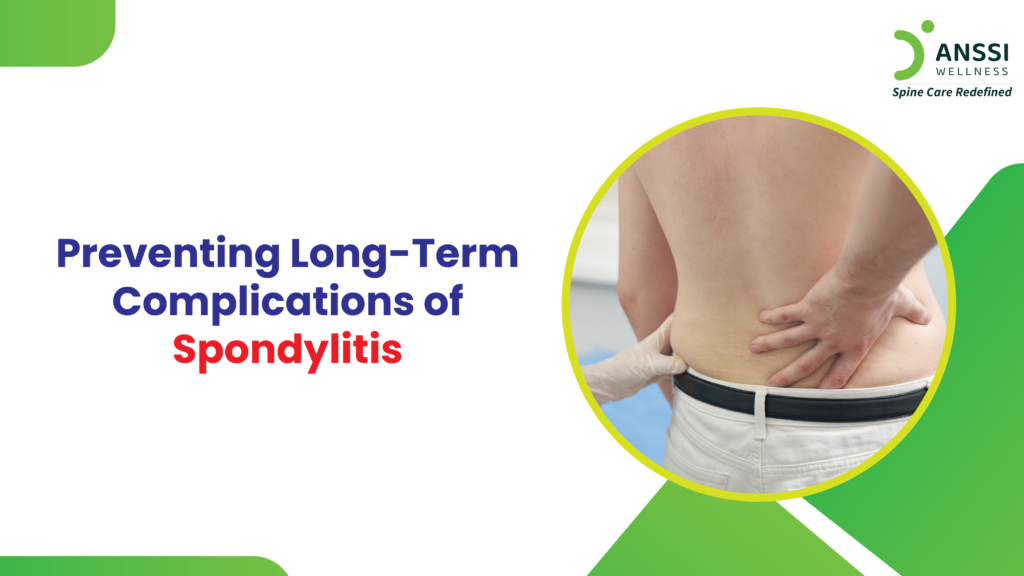Spondylitis is a chronic inflammatory condition that affects the spine and can lead to severe complications if not managed properly. Without timely intervention, it may cause spinal fusion, nerve damage, and long-term disability.
Fortunately, early diagnosis, lifestyle modifications, and non-invasive treatments like spinal decompression can help prevent these complications and improve quality of life.
Understanding Spondylitis and Its Risks
Spondylitis, particularly Ankylosing Spondylitis (AS), causes inflammation in the spinal joints. Over time, this inflammation can lead to pain, stiffness, and structural damage.
If left untreated, spondylitis may result in:
- Spinal Fusion: Chronic inflammation can cause new bone formation, leading to the fusion of vertebrae. This restricts mobility and increases the risk of fractures.
- Nerve Damage: Compressed nerves due to inflammation or bone growth can cause pain, numbness, or weakness in the limbs.
- Postural Issues: In severe cases, spinal fusion can lead to a hunched-forward posture (kyphosis), affecting balance and daily activities.
- Breathing Difficulties: If the condition affects the rib joints, lung expansion may become limited, leading to respiratory issues.
- Chronic Pain and Disability: Persistent inflammation can cause long-term discomfort, reducing mobility and overall quality of life.
The good news is that many of these complications can be prevented with proactive care.
Early Diagnosis: The Key to Prevention
Early detection of spondylitis can significantly slow its progression. If you experience persistent back pain, morning stiffness, or difficulty bending, consult a healthcare professional for:
- Medical History and Physical Exam: Doctors assess symptoms, mobility, and family history.
- Imaging Tests: X-rays, MRIs, or CT scans detect structural changes in the spine.
- Blood Tests: Certain markers, like HLA-B27, indicate inflammatory conditions.
Timely diagnosis allows for an early treatment plan, preventing irreversible complications.
Lifestyle Changes for Spondylitis Management
Daily habits play a crucial role in managing spondylitis and preventing long-term issues. Consider incorporating the following:
1. Maintain Good Posture
Proper posture reduces strain on the spine and minimises the risk of deformities. Keep your back straight while sitting, standing, and walking. Ergonomic chairs and workstations can help maintain spinal alignment.
2. Stay Active with Low-Impact Exercises
Regular exercise strengthens muscles, improves flexibility, and reduces stiffness. Some effective options include:
- Stretching: Increases spinal mobility and reduces tightness.
- Swimming: A low-impact way to build strength without stressing joints.
- Yoga and Pilates: Enhance posture, flexibility, and core stability.
Avoid high-impact activities that put excessive pressure on the spine.
3. Follow an Anti-Inflammatory Diet
A healthy diet helps reduce inflammation and supports overall spine health. Such diet includes:
- Omega-3-rich foods (fish, flaxseeds)
- Leafy greens, berries, and nuts
- Whole grains and lean proteins
Avoid processed foods, excessive sugar, and refined carbs.
4. Maintain a Healthy Weight
Excess body weight adds stress to the spine, worsening symptoms. Effective weight management is aided by a healthy diet and regular exercise.
5. Quit Smoking and Limit Alcohol
Smoking worsens inflammation and reduces oxygen supply to spinal tissues, accelerating degeneration. Alcohol can also weaken bones, increasing the risk of fractures.
Non-Invasive Treatments for Spondylitis
While medications can help manage symptoms, non-invasive treatments provide long-term benefits without side effects.
Spinal Decompression Treatment
Spinal decompression is an advanced, non-surgical treatment that gently stretches the spine to:
- Reduce pressure on spinal discs
- Improve blood flow and nutrient supply to affected areas
- Relieve nerve compression and pain
- Enhance mobility and flexibility
This treatment is especially beneficial for spondylitis patients with nerve-related pain and stiffness.
Physical Therapy and Rehabilitation
A trained therapist can create a personalised exercise plan to strengthen back muscles, improve posture, and restore movement.
Heat and Cold Therapy
Applying heat relaxes muscles and improves circulation, while cold packs reduce inflammation and numb pain.
Chiropractic Care
Gentle spinal adjustments help maintain alignment and relieve stiffness.
Hydrotherapy and Massage
Water therapy and deep tissue massage improve circulation, reduce stiffness, and enhance muscle relaxation.
Avoiding Surgery: Why Non-Surgical Approaches Matter
Many spondylitis patients worry about surgery, but in most cases, it is avoidable with early intervention. Surgery is usually recommended only in severe cases of spinal fusion or nerve compression. Non-surgical treatments like spinal decompression, physical therapy, and lifestyle modifications provide effective relief without the risks and recovery time associated with surgery.
About ANSSI:
ANSSI Wellness focuses on improving the quality of life for patients suffering from spinal issues, aiming to provide relief where other conventional treatments have failed. Through advanced non-surgical spinal decompression treatment, ANSSI is committed to helping patients avoid surgery and recover in a safe, effective, and compassionate environment.
Connect with ANSSI Wellness on LinkedIn, Instagram, and Facebook for expert guidance.



